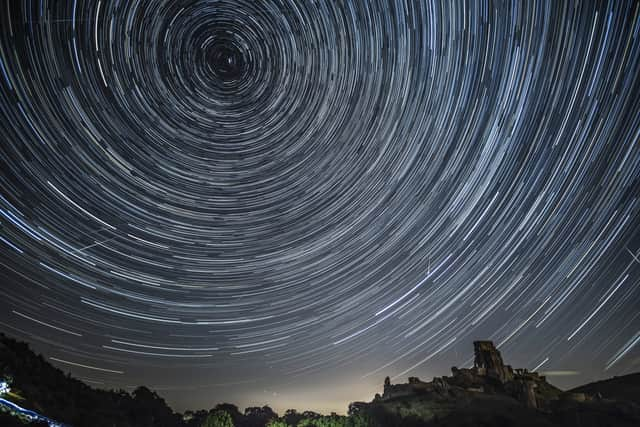Perseids Meteor Shower 2023: when is peak in UK, where to look tonight - and best time in August to see
and live on Freeview channel 276
The Perseid meteor shower is expected to light up the night sky this weekend, and could turn out to be one of the most spectacular events of the year for astronomers, with up to 150 shooting stars streaking through the sky per hour.
Taking place in July and August every year, the display is caused by Earth colliding with the debris left behind by comet 109P/Swift-Tuttle. The comet itself hasn't been seen from Earth since 1992 - and won't be seen again until 2126.
Advertisement
Hide AdAdvertisement
Hide AdThough the tiny particles of rock dust that make up the debris cloud are often no bigger than a grain of sand, as they burn up upon entry to Earth's atmosphere, the intense heat and light released cause a visible streak against the blackness of the night sky.
They are known as "Perseids" because the point in the sky from which the meteors appear to originate (the radiant) lies in the constellation Perseus.
The shower is considered one of the best of the year because it produces bright meteors and is one of the most active. There is also a high chance of seeing fireballs, which are very bright meteors, as well as meteors with long trains.
In an average year, the Perseid meteor shower produces around 50 to 100 meteors per hour. But some exceptional years have been known to deliver over 150 within an hour, making for quite the spectacular display.
Advertisement
Hide AdAdvertisement
Hide AdIt's incredibly difficult to predict which years will see these heightened displays occur, so nobody really knows if 2023 will be particularly bountiful. We'll just have to wait and see!


When is the Perseid meteor shower in 2023?
The Perseid meteor shower falls between July and August every year, and in 2023, it has been lighting up the night sky since 17 July.
However, the meteors won't reach their peak for another few days, so it's best not to get too excited just yet. While you might see one or two "shooting stars" if you look to the skies, the peak of the shower doesn't fall until the evening of Saturday 12 August.
That's the night when you'll want to look towards the heavens for the best chance at spotting the Perseids. But though there's a relatively long build-up to the main event, once the Perseids have peaked, the whole thing will be over just a few days later on Thursday 24 August.
How can I see it?
Advertisement
Hide AdAdvertisement
Hide AdObservers can look out for the shower wherever they are in the UK, but a clear sky with minimal light pollution offers the best chance of catching a glimpse.
You’ll likely still be able to see the brighter meteors from wherever you are, but finding a spot away from city lights and light pollution will increase your chances of seeing even more.
Unlike last year's shower, which was hampered by the full moon coming around the same time (meaning light conditions were not ideal), this year the Perseids will be well clear of August's full moon, which falls on the first of the month in 2023. In fact, the Moon won't even be a quarter full come the peak of the shower.
Once you’re in your chosen viewing spot, give your eyes time to adjust to the dark. You might think this would only take around a few minutes, but it can take about 20 minutes for your eyes to properly adjust to low light levels, so be patient.
Advertisement
Hide AdAdvertisement
Hide AdObserving the meteor shower can take some time, so make sure to bring something comfortable to sit on, and check the weather forecast and dress appropriately for the conditions.
It may also be tempting to whip out a pair of binoculars to get a closer view of the meteors, but these will actually narrow your field of view, making it even harder to spot the shooting stars as they whizz across the sky (they’re still useful for observing other celestial objects like the Moon and planets of our Solar System though).
What will the weather be like this weekend?
Of course, the famously changeable British weather could put a stop to any plans to see the meteors at a moment's notice, so it's always a good idea to keep one eye on the forecast.
Though the weekend is a few days away at the time of writing, the Met Office's predictions for 11 to 20 August say that "a mix of conditions is likely for many parts.
Advertisement
Hide AdAdvertisement
Hide Ad"A band of cloud moving eastwards is likely to bring outbreaks of rain, perhaps heavy for some. However, mostly dry and bright conditions on either side of the band of cloud, with some showers possibly developing in the west."
Comment Guidelines
National World encourages reader discussion on our stories. User feedback, insights and back-and-forth exchanges add a rich layer of context to reporting. Please review our Community Guidelines before commenting.
